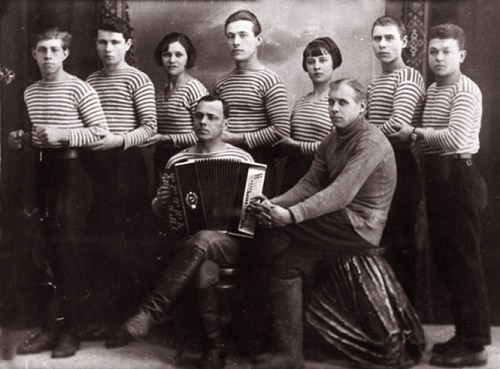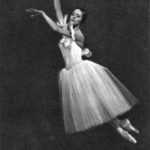Soviet agitprop theater Blue Blouse

Theatre Magazine Blue Blouse, dedicated to the fifth anniversary of the theater. Soviet agitprop theater Blue Blouse
Soviet agitprop theater Blue Blouse
Blue Blouse – Soviet theater of small forms, kind of campaign platform. It existed from 1923 to the beginning of the 1930s. For the first time established in Moscow at the Institute of Journalism, on the basis of a “living newspaper”; initially – theatrical troupe (the participants were working in a blue blouse – hence the name). The initiator of its creation, the author and one of the artists B.S. Yuzhanin. Soon appeared further 15 such groups. The subjects of their repertoire was topical, it combined the heroism and pathos, satire and humor. Program of Blue Blouse was built mainly on a collective recitation, folk songs and sport dances. Blue Blouse team performed in “Red corners”, clubs, shops of factories. Similar groups sprang up in other cities, serving as a basis for the creation of a number of professional theaters and giving impetus to the search for new forms of theater and variety of performances. In the Blue Blouse began creative work many Soviet writers, composers, actors, directors and artists. Besides, several groups of Blue Blouse toured abroad (Germany, Poland, Scandinavia, and China), influencing the theater movement in different countries.
Theater Actors wore badges, one – a symbolic image of a worker, the same as on the theater seal, and its posters, and another – in the form of a banner. In the future, similar in spirit to other artists and pop theaters public figures received such badge as the award.
“Blue Blouse” spawned thousands of followers. Within 5 years, according to the “Blue Blouse” in the USSR operates 7000 such groups, professional and mostly amateur. Their repertoire consisted of literary montages, reviews, sketches, reflecting the industrial and social life, and international events. Subject was topical, it combined the heroism and pathos, satire and humor. Initially, the theater consisted of three groups, and in the winter-autumn season 1929-30s there were 12 groups of actors: the main, central, basic, music hall, pop, industrial, operational, production, concert, tenth, regional, and experimental. Each – with its own repertoire.
The repertoire of the Moscow “Blue blouse” consisted of about two thousand variety acts. Each program consisted of 10-12 acts and lasted half an hour. Blue Blouse agitation teams acted with propaganda artistic poetry, choral speaking, sports scenes, and sports dances. Merge onto factories, clubs, went through the cities and villages of the country, some groups even toured abroad. Usually performances started with march – parade (entree).
Many Soviet writers, composers, actors, directors and artists created variety performances for “Blue Blouse”. In particular, Vladimir Mayakovsky, Sergei Yutkevich, Vasily Lebedev-Kumach, and young writers, poets, and playwrights.
One of the ideologists of the “Blue Blouse” was Osip Brik.
Under the same name – “Blue Blouse” in 1924 in Moscow published print edition almanacs; intended for various Blue Blouse groups containing repertory materials, methodical and directing, staging instructions, comments, recommendations, and so on.
In October 1926, Moscow hosted the All-Union Congress of Blue Blouse, presented by 5000 groups.
During its heyday, “Blue Blouse” successfully competed with the professional platform, and even performed in the Hall of Columns, the Moscow Operetta Theater “Alcazar”, and “Hermitage”.
Every year, it toured the country: the Volga region, the Urals, Siberia and the Caucasus, Turkestan, and others.
Great response received foreign tour in Germany (1927, 100 performances) and Latvia (25 shows in (1927), as well as in Manchuria and China (1928). Muscovites were in constant communication with foreign Blue Blouse theaters in England and China, Germany and Czechoslovakia, France and the United States. Abroad, there were more than 80 teams of agitprop theater Blue Blouse.
Soviet agitprop theater Blue Blouse
Poster style, an appeal to the mind of the viewer more than a feeling, an acute response to “One Day” made the feature “Blue Blouse”, which proved to be its eternal contribution to the art world. The success of the new art was great. “Blue Blouse” was the first Soviet theater, to travel abroad. Triumphant trip, the invitation to America, sold out everywhere.
“Blue Blouse” has received considerable attention abroad, where there was a lot of followers. Among them “Left Column”, “Red Horns”, “Alarm” and others in Germany, a group of “October” and “Blue blouse” in France.
In the United States held the Pan American Competition of revolutionary agitprop groups. In addition, such groups appeared in the countries of Asia and Africa.
The typical characters of the Blue Blouse political performance were capitalist, banker, premier, NEPman, Kulak, Menshevik, Social Revolutionary, General, Female Worker, Female Komsomol, Red Army Man, the Peasant, and the Worker. All of these characters were extremely pertinent at the time and carried strong political messages.

Agitation team of Blue Blouse theater. Spassk. 1927 historical and political documents of Central State Archive of the Republic of Tatarstan

Performing actors of the theater Blue Blouse. Second from left – head of the group K.M. Kvitnitskaya. 1928
sources:
da-het.livejournal.com
Big Soviet Encyclopedia
Literature: Album Blue Blouse of the USSR. Moscow. 1928.
E. Ardov, Spoken genres on the stage. Moscow, 1968






























